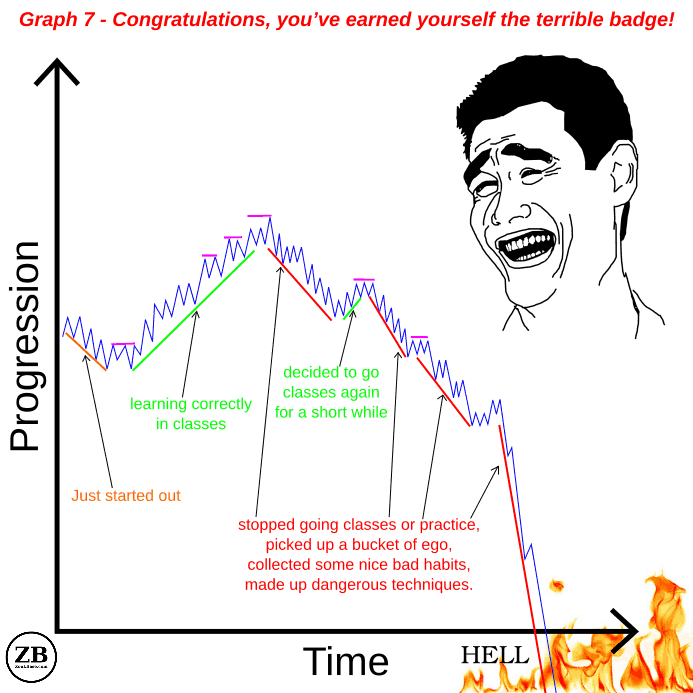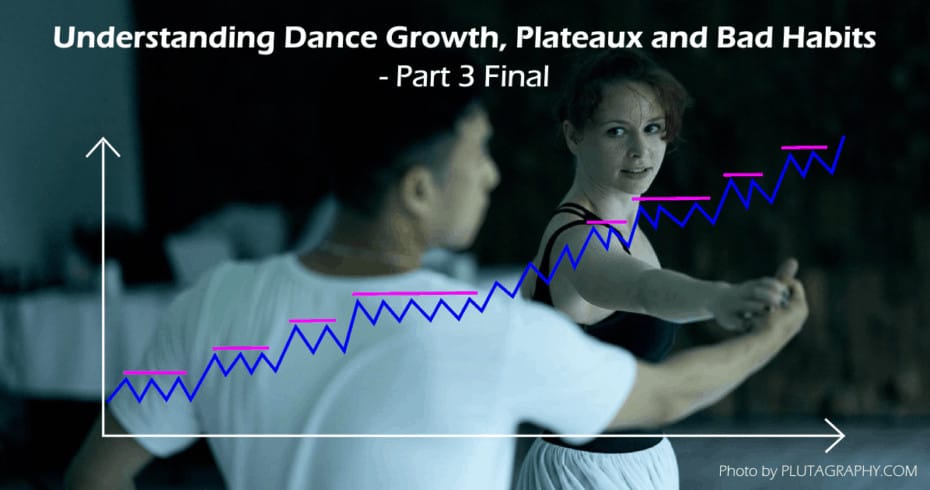This is the 3rd and final part of ‘Understanding Dance Growth, Plateaux, and Bad Habits’. Click here to start with part 1 if you’ve not read it yet.
Building a dance solid foundation.

I’m sorry to be the one telling you this, but there is no quicker way to learning to dance. If someone tells you otherwise or is selling you the idea that they know shortcuts, then they probably don’t know how to dance and you shouldn’t be listening to them.
The only shortcut is learning right the first time.
In order to build a solid dance foundation, check out “A Guide to Different Types of Zouk Classes“. It will give you some ideas in the right direction.
Graph 6 shows the ideal reason why you would want to build a solid dance foundation and once you have hit the breakthrough stage, your development would accelerate.
The acceleration phase is a phenomenon because you will find everything just makes sense. You can see and understand the mechanics of dance by watching, feeling and asking a few right questions. The best bit is… your body becomes a learning sponge and drilling a new movement or technique seems to take only half the time or less!
The time it takes for you to build a solid dance foundation will vary from person to person, so if it takes you more than 1000+ hours of practice – don’t worry. It’s all about consistency and turning up to classes and practicing every week.
The reason why I chose to explain in practice hours rather than how many years is because I want you to take note of this important metric and magnitude it requires to be somewhat proficient at dancing Brazilian Zouk. Someone who practices 1 hour a week for 3 years will obviously have a different progression compared to someone who practices 7 hours a week for 3 years.
A very important note is dance foundation isn’t something that you develop only once, it’s actually an ongoing reinforcement process even after reaching the acceleration breakthrough point.
The stronger your dance foundation, the more amazing and complex techniques can be utilised simultaneously into your dance, without having toppling effects.
Special bonus for reading this far.

Graph 7 is just an exaggerated and funny illustration of one of many ways to become a terrible dancer. They never gave adequate time and patience to learn and build a solid dance foundation but in their minds, they are gods gift to Brazilian Zouk.
DO YOU REALLY WANT TO BE OR BECOME THIS?
This is the path of no return as I rarely see these dancers recover from this state. My definition of terrible dancers are not often not based on their dance abilities but mostly to do with egoism and lack understanding for health & safety, which causes an adverse effect on their overall progression as a dancer.
If a terrible dancer decides to stick around in the Brazilian Zouk scene for a while, then they will possibly be a danger and a high chance of injuring themselves or someone else. I know a handful of dancers injured this way including myself, some with longer-term damages and their sorry’s can never reverse the psychological and physical damages caused.
Even if these terrible dancers decided to stop dancing Brazilian Zouk and start doing other dances, they will pretty much bring over their personality, bad habits, and incorrect techniques because many types of dances have overlapping techniques in dance foundations. So now they are just a problem for another dance community.
Here are a few pointer tips to prevent the point of no return:
- Regular ego check.
- Always aim to improve yourself by attending regular classes and practices.
- Work on your partner listening skills.
- Develop floorcraft skills. Not sure what is floorcraft? Here’s a blog which explains this very well and also worth reading the comment at the end of the article. SOCIAL DANCING FLOORCRAFT – DANCE FLOOR SURVIVAL BASICS (PART 1).
- Remember, social dancing isn’t about only YOU.
Final Words.
I hope you enjoyed this blog series had it had helped set some of your learning expectations and offered some tips for improving.
It is very difficult to reach the desired acceleration stage as much hard work, practice, patience, dedication, money, doubt, frustration, and blood is needed to get to this stage.
Those who do not want or can not put in the amount effort should not be discouraged because you can still have lots of fun dancing with knowing just the simple basic movements with little or no technique (for your own and others health and safety, just stick to those unless you plan to take it seriously).
You may wonder what is progression and how is it defined? — While I write the next blog on this topic, I’d like you to think how would you measure your own progression?
How many acceleration phases do you think a dancer experiences?
What I would like to ask those who had been dancing Zouk for a while is to think about your own Zouk progression vs time graph. It is even better if you could sketch it onto a piece of paper, take a photo on your phone and share it on Facebook as a comment to this post / private message me on FB / drop an email to me on [email protected].
This would be very interesting to see and please be as honest and realistic as you can.
Thank you and I look forward to reading all your comments!
If you liked this blog and also have friends who recently started out their dance journey, then please share this with them.
Hoi x


Nice series!! To expand on graph 6 which I actually think varies a little between leading and following previous dance experience etc…also ties in with the 7 reasons to practise solo….would be “penny drop moments”….ie when suddenly a movement or concept makes sense. These have been more evenly spread out for me, but I am a follower so we are given more opportunities to pracrise a variety of movements from the start.
Keep up the good work 🙂
That’s very interesting to know that your progression had been very steady as a follow.
Did you do any other dances prior to Zouk?
Are there any other follows reading this who felt the same having had a steady progression rather than an accelerated breakthrough?